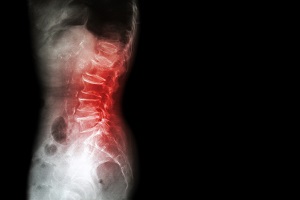What is Degenerative Spondylolisthesis?
Spondylolisthesis (spon-di-loh-lis-thee-sis) is a condition where one vertebra has slipped forward over another one below it. This misalignment typically occurs as a result of advanced degenerative disc disease (DDD), stress fractures, or congenital abnormalities, and in rare cases from a tumor or trauma. Degenerative spondylolisthesis is a consequence of the aging process in which the bones, joints, and ligaments in the spine grow weakened and become less able to maintain the alignment of the spinal column. This type of spondylolisthesis most commonly occurs at the L4-L5 levels of the lumbar spine, but it can also occur at other levels.
Degenerative spondylolisthesis is more common in people over age 50, and in particular, among individuals over age 65. Women are two-to-three times as likely as men to be diagnosed. Spondylolisthesis can cause impingement of the nerves and/or fatigue of the back muscles, and may result in lower back and/or leg pain.
Common Symptoms of Degenerative Spondylolisthesis:
• Lower back and/or leg pain
• Sciatica, an aching pain in the hip, buttocks, and lower back that radiates (spreads) into the back of the thigh and leg
• A shuffling gait when walking
• Weakness in the lower extremities
• Abnormal posture
Diagnosing Degenerative Spondylolisthesis:
Your doctor will perform a physical examination to identify areas of pain and weakness, and will evaluate your balance and the overall movement of your spine. Your doctor will also collect information about the history of your symptoms, including medicine you have taken for your condition. After your examination, your doctor may use tests to help establish his or her diagnosis. Some of these tests may include x-ray, CT (computed tomography) scan, and MRI (magnetic resonance imaging). Together, all of these techniques may help to confirm a diagnosis of spondylolisthesis.
Treatment options:
The following provides an overview of standard non-surgical and surgical treatments for spondylolisthesis.
Non-surgical treatment:
If spondylolisthesis is established as a diagnosis, your doctor will likely recommend one or more of the following treatments:
• Physical therapy and strengthening exercises.
• Rest and a restriction of physical activity.
• Injections (corticosteroids) to help reduce the pain and swelling.
• Medications and analgesics to reduce pain and swelling. Typical medications include non-steroidal anti-inflammatory drugs (NSAIDs).
Your doctor can discuss recommended treatment options based on your individual needs.
Surgical treatment:
If surgical treatment is determined to be the best course of action, spinal restoration surgery is done to reduce motion between the vertebrae, correct alignment, and restore disc height and normal lumbar curvature. During the procedure the surgeon removes most of the disc between the two bones that are to be stabilized and implants a spacer to restore correct spinal alignment. The surgeon may also utilize bone grafting materials that bridge the space between the vertebrae and encourage the bones to grow together. Increased stability and restoration of disc height and alignment often result in significant pain relief.
Below are some of the surgical procedures used to treat degenerative spondylolisthesis.
• Maximum Access Surgery Posterior Lumbar Interbody Fusion (MAS® PLIF):
Posterior lumbar interbody fusion (PLIF) is a surgical technique that attempts to eliminate instability in the back and pain in the lower back and lower extremities. A MAS PLIF achieves this by using a less disruptive approach to decompress nerve roots and fuse one or more vertebrae together to reduce motion. Learn more about the MAS PLIF procedure here.
• Maximum Access Surgery Transforaminal Lumbar Interbody Fusion (MAS TLIF):
The MAS TLIF procedure is a technique that attempts to eliminate instability in your back through a less invasive approach to fuse one or more vertebrae together to reduce motion. Learn more about the MAS TLIF procedure here.
• eXtreme Lateral Interbody Fusion (XLIF®)
The XLIF procedure is a minimally disruptive surgical procedure performed through the side of the body. It is designed to treat a range of spinal conditions. Using patented nerve monitoring technology, the surgeon gains lateral (side) access to the spinal column, helping to avoid any major nerves in the area between the incision and the spine. The XLIF procedure does not require an anterior (front) or posterior (back) exposure, and therefore does not present the same risks of vascular and/or neural injury as traditional approaches. Learn more about the XLIF procedure here.
I have more questions, who can I ask?
In addition to consulting with your physician and medical teams, it often helps to speak to someone who has had a similar condition. To connect with a Patient Ambassador dealing with spondylolisthesis, please complete our request form.
NOTE:
While this website provides information about many different non-surgical and surgical options, it is not meant to replace any personal conversations that you should have with your physician or other member of your healthcare team.
Not all the information here will apply to your individual treatment or its outcome. The information is intended to answer some of your questions and serve as a guideline for you to ask your healthcare team appropriate questions about the procedure.

